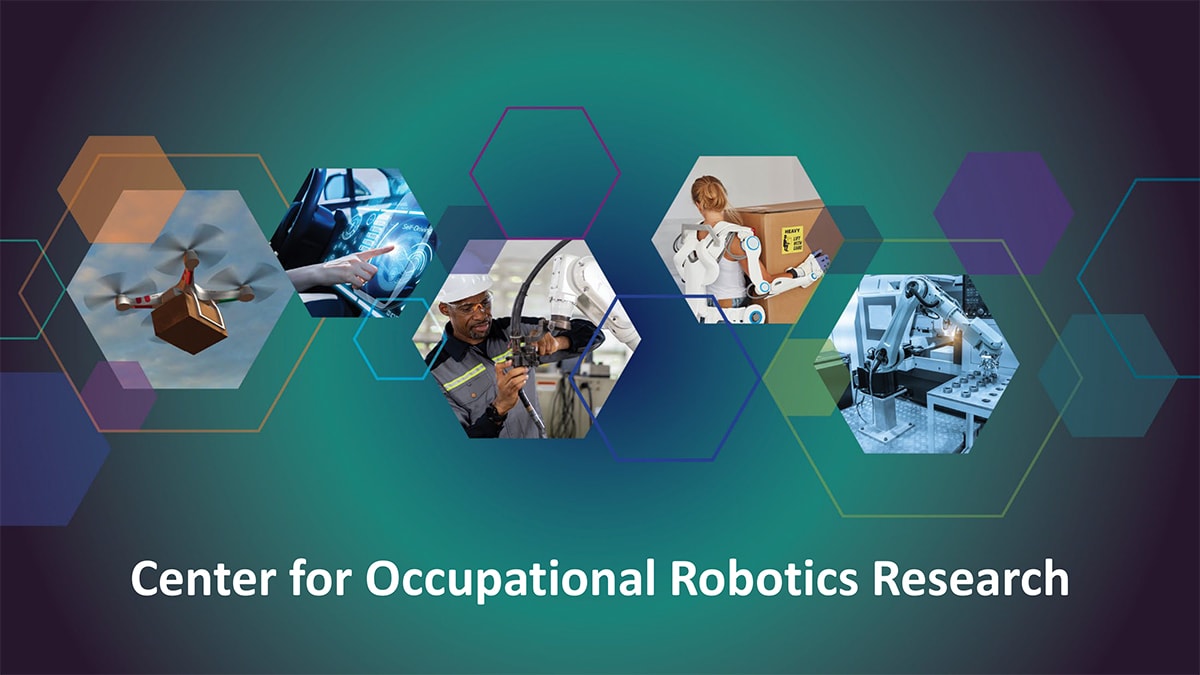Key points
- Takes a proactive role in enhancing safety in the rapidly evolving field of robotics in the workplace.
- Provides scientific leadership for development and use of occupational robots that enhance worker safety and health.
- Plays a critical role in monitoring injury trends, evaluating the safety of robotic technologies, and advocating for safety standards.

Overview
NIOSH established the Center for Occupational Robotics Research in September 2017 to address the safety of today’s workers who use, wear, or work near robots. The Center provides scientific leadership to guide the development and use of occupational robots that enhance worker safety, health, and wellbeing.
Background
NIOSH conducted extensive robotics safety research when robots began appearing in the workplace in the 1980s. This research was limited to robots designed to work in isolation from workers, such as robots in cages or cells. The increase in robots and advances in their capabilities led to the Center's creation.
What we do
To address robot-related injury and death, the Center works with partners to:
- Monitor trends in injuries associated with robotics technologies
- Evaluate robotics technologies as sources of, and interventions for, workplace injuries and illnesses
- Establish risk profiles of robotic workplaces
- Identify research needs and conduct research to improve the safety, health, and wellbeing of humans working with robots and robotic technologies
- Support the development and adoption of consensus safety standards
- Develop and communicate best practices, guidance and training for safe interactions between human workers and robots/robotics technology
Program priorities
The Center's research and efforts address:
- Traditional industrial robots, such as work in robotic cells and cages away from human workers
- Emerging robotic technologies, such as:
- Collaborative robots
- Co-existing or mobile robots
- Wearable robotics or powered exoskeletons
- Remotely controlled or autonomous vehicles and drones
- Future robots that will increasingly use advanced artificial intelligence
What we've accomplished
In 2017 NIOSH established an alliance with the Association for Advancing Automation and OSHA to do the following:
- Improve awareness of occupational hazards from traditional industrial robots and emerging robot technologies.
- Promote best practices for controlling exposures to mechanical, electrical, and other hazards involving human interaction with robotic systems, including potential areas for additional NIOSH research.
- Help develop educational resources, such as fact sheets, on using robotics system safety practices and safety and health programs.
Additionally, NIOSH has:
- Partnered with the National Robotics Initiative to include worker safety research in a multi-agency funding opportunity announcement. NIOSH has funded two grants, and the National Science Foundation and other agencies have funded additional research addressing worker safety.
- Developed relationships with universities that enable collaborative robotics research between the institutions and provide educational opportunities for students.
What's ahead
- Publish research that advances knowledge on the use of robots to prevent work-related injuries
- Partner with employers to establish risk profiles for robotics applications
- Contribute to updated American National Standards Institute/Robotics Industry Association standards on occupational robot safety
Contacts
For more information or inquiries about the Center's initiatives, contact the Center for Occupational Robotics Research at CDC-INFO.
Research
The Center's research needs are consistent with the robot-related research goals outlined in the NIOSH Strategic Plan: FYs 2019-2026 that are encompassed in four Strategic Goals:
- Reduce Immune, Infectious, and Dermal Disease
- Reduce occupational musculoskeletal disorders
- Improve workplace safety to reduce traumatic injuries
- Promote safe and healthy work design and well-being
Visit the NIOSH Robotics topic page to learn more about the research needs the Center will address.
Resources
NIOSH works with external partners to advance robotics research and prevention strategies to keep workers safe on the job. These include
- Advanced Manufacturing for Robotics Institute
- OSHA, A3, NIOSH Alliance
- National Institute of Standards and Technology
- National Science Foundation, National Robotics Initiative
- Occupational Safety and Health Administration (OSHA)
- Association for Advancing Automation (A3)
- The Networking and Information Technology Research and Development Program
- Work to Zero – National Safety Council
- Layne LA. Robot-related fatalities at work in the United States, 1992–2017. American Journal of Industrial Medicine. 2023. Though a Memorandum of Understanding with BLS, NIOSH receives CFOI research files with restricted access requirements. Research for this document was conducted by NIOSH using these restricted access files. The views expressed herein do not necessarily reflect the views of BLS.
